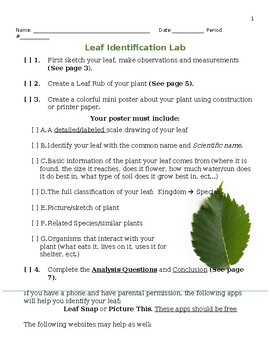Leaf Measurement, Identification and Nature of Science Activity
Evanrose Science with Mr DAlsace
0 Followers
Grade Levels
5th - 9th, Homeschool
Subjects
Resource Type
Standards
NGSSMS-LS2-2
NGSSMS-ETS1-1
Formats Included
- Word Document File
Pages
8 pages
Evanrose Science with Mr DAlsace
0 Followers
Description
This activity asks students to find a leaf and Identify it through the gathering of information. Students will need to bring in a leaf (or the teacher can gather leaves for students to choose from). Students will work on their measurement and observation skills as they gather information on the Leaf. They will create a leaf rub by placing the leaf under a page of the lab and rubbing it with a colored pencil or crayon. Students will use apps or websites to identify the leaf. They will then use their knowledge of science and the internet to answer analysis questions. This activity connects to the nature of science, measuring, observing, characteristics of life, classification and the fall equinox)
Materials needed:
- Leaves (collect yourself or have students bring them from home)
- colored pencils/crayons
- rulers (balances are optional)
- access to internet - can be for all students, in stations or just for the teacher.
Total Pages
8 pages
Answer Key
N/A
Teaching Duration
3 days
Last updated Feb 16th, 2023
Report this resource to TPT
Reported resources will be reviewed by our team. Report this resource to let us know if this resource violates TPT’s content guidelines.
Standards
to see state-specific standards (only available in the US).
NGSSMS-LS2-2
Construct an explanation that predicts patterns of interactions among organisms across multiple ecosystems. Emphasis is on predicting consistent patterns of interactions in different ecosystems in terms of the relationships among and between organisms and abiotic components of ecosystems. Examples of types of interactions could include competitive, predatory, and mutually beneficial.
NGSSMS-ETS1-1
Define the criteria and constraints of a design problem with sufficient precision to ensure a successful solution, taking into account relevant scientific principles and potential impacts on people and the natural environment that may limit possible solutions.





